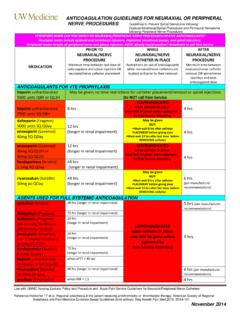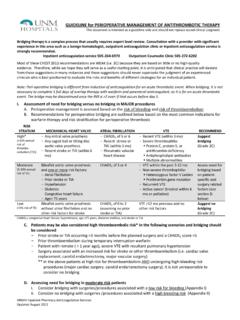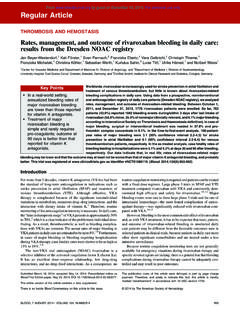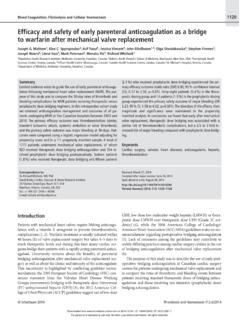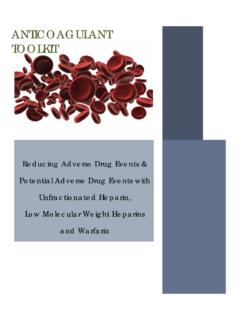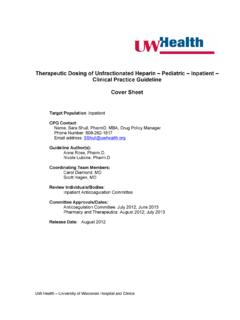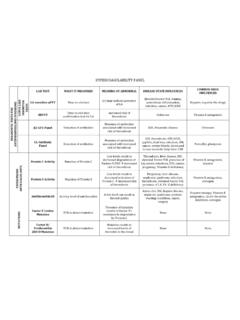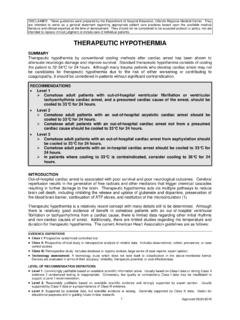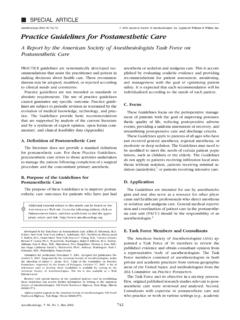Transcription of Kaiser Permanente NCAL Perioperative Anticoagulation ...
1 Kaiser Permanente NCAL. Perioperative Anticoagulation Management guidelines I. PURPOSE. To provide guidelines for the use of Anticoagulants including, but not limited to warfarin and low molecular weight heparin (LMWH, or Enoxaparin) as part of an outpatient management program for patients who require a surgical or other invasive procedures. Outpatient Anticoagulation Service (OACS) currently only manages patients on warfarin therapy. Peri-op management of other anticoagulants and anti-platelets is the responsibility of patient's treating physician. II. GOALS/OBJECTIVES. To provide safe and effective medication therapy management for patients before and after surgery or other invasive procedures NOTE: Due to lack of prospective data and individual variability in risk for thrombosis and bleeds, Perioperative Anticoagulation management remains controversial. Individual provider-patient decisions may differ from the guideline below. Clinical judgment must be exercised.
2 III. PROCESS. Physicians and Surgeons Responsibilities: 1. Inform Outpatient Anticoagulation Service (OACS) of the planned procedure including type of procedure, date of procedure, and any specific instructions outside of this guideline using CC. Chart in HealthConnect to OACS pool address p ** coag pha (refer to SECTION VI for complete address). Elective procedures may need to be postponed if OACS are not notified at least 1 week in advance to coordinate bridging plan. 2. Notify OACS via CC Chart if a physician desires to modify the patient's Perioperative Anticoagulation plan, generated by the Anticoagulation Service Pharmacist. Consider sending E-Consult to Anticoagulation Service for problem/reason of Perioperative Bridging . 3. Instruct patient on resumption of warfarin/LMWH therapy after procedure when adequate hemostasis is obtained and inform Anticoagulation Service via CC chart. 4. Notify OACS via CC Chart when discontinuing patient's Perioperative Anticoagulation therapy post procedure.
3 5. Instruct patient on holding parameters for non-warfarin oral Anticoagulation such as Dabigatran and antiplatelet therapy such as aspirin, clopidogrel (Plavix), dipyridamole/asa (Aggrenox). 6. For patients on warfarin, recommend pre-op INR check one day prior to procedure and treat with vitamin K tablet mg orally if INR > when deemed appropriate. 7. POM will make sure that patients on chronic warfarin has a Perioperative bridge plan documented in KPHC under Peri-op Anticoagulation Management Plan and will notify OACS via CC Chart if it is not Version 2 approved by KP NCAL Regional P&T on August 24th 2012. Outpatient Anticoagulation Service (OACS) Pharmacist Responsibilities: 1. Once OACS is notified, pharmacist will clinically assess the patient's thromboembolic risk and the bleeding risk associated with the procedure, and then draws out a plan for the patient's Perioperative Anticoagulation therapy based on the clinical guidelines for Perioperative bridging.
4 2. Pharmacist will inform the surgeon, primary care physician, and POM of the Perioperative bridging plan via CC Chart. Pharmacist will document procedure plan in an encounter using chief complaint of Peri-op Anticoagulation Management Plan ID 3259. If a physician desires to modify the plan based on their knowledge of the patient's clinical status, he or she will notify OACS via CC Chart. 3. Pharmacist will monitor PT/INR, provide patient with appropriate daily warfarin and low molecular weight heparin (LMWH) dosage, and discontinue LMWH when therapeutic INR is reached and/or no longer indicated. 4. Pharmacist will order subcutaneous LMWH. Pharmacist will coordinate teaching of LMWH for patient or their caregiver of LMWH administration. In the event that patient is not able to self inject LMWH, pharmacist will coordinate for patient to receive the injections. 5. Patients requiring bridge therapy with LMWH will receive an outpatient Perioperative Anticoagulation bridge therapy letter generated using HealthConnect.
5 6. Pharmacist may instruct patient on resumption of warfarin/LMWH therapy after procedure based on the clinical guidelines for Perioperative bridging in the event that patient is unclear of post-procedure instructions. Pharmacist will inform the surgeon, referring physician, and/or POM of the plan using HealthConnect. Inclusion Criteria: Patients who require interruption in warfarin therapy for invasive procedures or diagnostic tests and are currently enrolled in the Outpatient Anticoagulation Services. Exclusion Criteria: Patients with any of the following conditions should be excluded from these guidelines and managed on a case-by-case basis: Age < 18 years Active major bleeding Physician desires to modify the protocol for their individual patient Patients with conditions or undergoing procedures not found in the clinical guidelines and recommendations for Perioperative bridging Caution: Consult Responsible Provider 1. Creatinine clearance / GFR less than 15 ml/minute 2.
6 Obese patients with weight > 150 kg, consider Anti- Xa monitoring 3. Hypersensitivity to LMWH, consider other parenteral anticoagulant ( Fondaparinux). 4. History of documented heparin-induced thrombocytopenia (HIT). Version 2 approved by KP NCAL Regional P&T on August 24th 2012. IV. CLINICAL guidelines AND RECOMMENDATIONS. 1. Enoxaparin (Lovenox) dosing for Perioperative Bridge Therapy After carefully assessing the thromboembolic risk and the bleeding risk, Pharmacist will use the Bridge Therapy Algorithm to determine the dose of enoxaparin to use for Perioperative bridging therapy: a. Therapeutic dose of enoxaparin for Perioperative bridging therapy. Dose should be calculated using actual body weight (ABW): i. Once Daily Dose = mg/kg, round to the nearest syringe size ii. Twice Daily Dose = 1 mg/kg, round to the nearest syringe size iii. CrCl/GFR < 30 ml/min: 1 mg/kg once daily, round to the nearest syringe size but not more/less than 5%.
7 B. Prophylactic dose of enoxaparin for Perioperative bridging therapy: i. Once daily dose = 40 mg ii. Twice daily dose = 30 mg iii. CrCl/GFR less than 30 ml/min: 30 mg once daily Enoxaparin is available in 30, 40, 60, 80, 100, 120, 150 mg/ml syringe sizes. Please refer to detailed dosing instructions on twice daily and once daily dosing of enoxaparin in timeline attached as Appendix A & B. NOTE: Consideration for once daily vs. twice daily dosing is based on many patient specific factors. Once daily dosing may improve compliance and it is more practical for patients who need to come into the medical center for their injections. Twice daily regimen may be considered for patients who are at higher risk for thromboembolic events and are able to self inject reliably twice daily. For example, patients with mechanical mitral valves or patients with Atrial Fibrillation with recent stroke/TIA within 3 months may be considered for twice daily dosing regimen.
8 Patients with a history of HIT need to be evaluated regarding risk vs. benefit of a simple warfarin hold with no bridging for necessary procedures. If bridging is needed, consider the use of non-heparin agents like lepirudin (Refludan), argatroban (Novastan), and fondaparinux (Arixtra). There is no data available to date regarding the safety for non-heparin agents in Perioperative management. Consult the responsible provider. 2. Perioperative recommendations for Dabigatran (Pradaxa) (managed by treating physicians). Dabigatran (Pradaxa). a. LMWH bridging is currently not recommended for patients on dabigatran b. There is currently no clinical evidence for the use of dabigatran in patients with CrCl < 30. ml/min. Therefore, the use of dabigatran in this patient population is currently not recommended. If dabigatran is being used in patients with CrCl 15 -30 ml/min, the FDA. recommends dose reduction to 75mg orally BID based on pharmacokinetics.
9 Version 2 approved by KP NCAL Regional P&T on August 24th 2012. c. Dabigatran is contraindicated in patients with CrCl < 15 ml/min d. Recommend measuring activated partial thromboplastin time (aPTT) pre-op. Dabigatran has been shown to prolong aPTT by increasing peak level by 2x control and median trough level by control approximately. e. Restart dabigatran once hemostasis has occurred post procedure Pre-op Recommendations for dabigatran (Pradaxa) hold Renal Clearance High Bleeding Risk* Standard Bleeding Risk (CrCl in ml/min). 50 Hold 3 days prior Hold 1 day prior > 30 to < 50 Hold 4 days prior Hold 2 days prior < 30 Hold 5 days prior Hold 2 to 5 days prior * High bleeding risk includes major surgery, spinal puncture / epidural catheter, or in whom complete hemostasis may be required. If Dabigatran is held for more than 2 days in patients with normal renal functions and more than 4 days in patients with reduced renal functions, please consult the treating physician or the cardiologist to decide on the need for Bridge therapy.
10 NOTE: Check aPTT prior to procedure to ensure dabigatran has been cleared from the system. References: 31, 32. 3. Perioperative recommendations for Antiplatelet drugs (managed by physicians). CAUTION: Patients with Coronary Stents In patients with coronary stents, please do not stop antiplatelet medications ( aspirin, thienopyridine, clopidogrel, prasugrel, ticagrelor) without consulting patient's cardiologist. Defer all elective surgeries for at least 4 weeks after placement of bare metal stent and 12 months for drug eluting stent. Elective surgery may be considered earlier if 1) the surgery can be performed on aspirin and thienopyridine, and 2) the cardiac risk has been discussed with cardiology For further information, refer to Perioperative Medicine guidelines 2012 Antiplatelet Management in Coronary Stents". Version 2 approved by KP NCAL Regional P&T on August 24th 2012. Recommendations for Perioperative Management of Aspirin Type of Procedures Cardiovascular (CV) Risks Recommendation (grade 2C).
